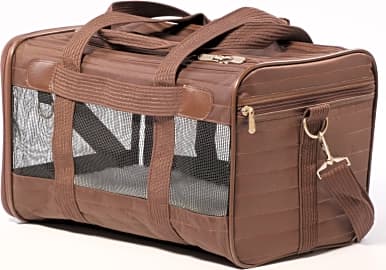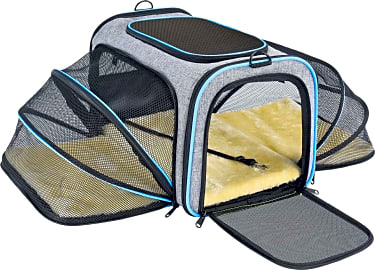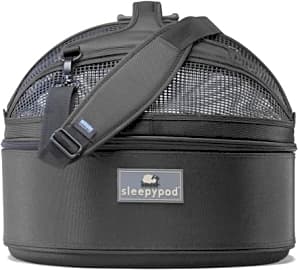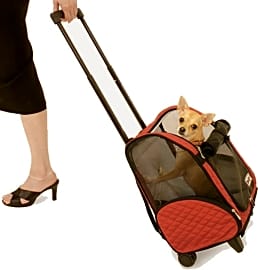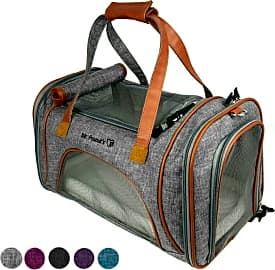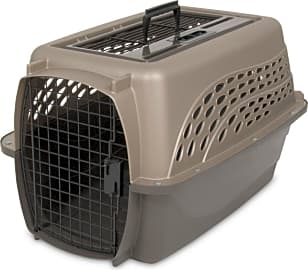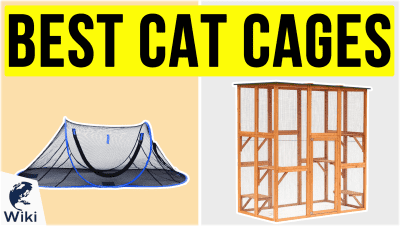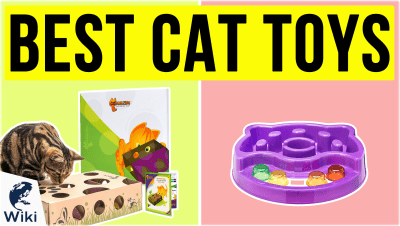The 10 Best Cat Carriers

This wiki has been updated 38 times since it was first published in May of 2015. Regardless of your destination or the method of travel being used to get there, you can transport your feline friends safely and comfortably wherever you go by placing them in one of these convenient cat carriers for the trip. Our selections for this category include a variety of styles, including several models that meet common specifications dictated by commercial airlines. When users buy our independently chosen editorial picks, we may earn commissions to help fund the Wiki.
Editor's Notes
April 07, 2021:
With every one of our picks from last year still being available and in good standing, and quite a few even now being offered in additional sizes or colors, we saw no need to make any major changes to this list. It looks like the last editor for this page did a good job of putting together a nice mix of options that will suit a range of budgets, style preferences and practical needs, so we made it through this update leaving these rankings relatively untouched. If you’re looking for more of a permanent, at-home solution, you might have better luck with our list of cat cages.
February 06, 2020:
During this round of updates, in order to make room for incoming additions we removed the SportPet Travel Master, PetTech Pet and Pet Magasin Soft-Sided, noting user reports of production problems or design flaws. Our new selections are the Kurgo Wander Metro, a well-designed, airline-compliant model that’s supported by a lifetime warranty; the Omorc Travel Bag, an expandable option that offers pets more than four square-feet of living space when full-sized; and the SlowTon Sling, which isn’t a suitable option for traveling by plane or car, but still a nice choice for pet owners who like to take their cats for a walk around town, from time to time.
A few considerations that carry weight in this category:
Capacity: A good place to start when assembling your shortlist for this purchase is making sure that you’re only considering options with load capacities that exceed your cat’s weight. While it's still important to take into account the interior dimensions of each carrier in relation to your cat’s size, it’s unlikely that a carrier with a serviceable weight capacity is going to be too small for your pet.
Comfort: This consideration combines a number of factors that need to be weighed according to your cat’s preferences (we all know how finicky they can be). While cats that are well-adjusted to travel might prefer well-windowed options like the Pet Luv Happy Cat Premium or Sherpa Deluxe, skittish felines might favor the privacy of a more-enclosed carrier like the Omorc Travel Bag or Sleepypod Air.
The padding that lines the bottom of each carrier can also have quite an impact on your cat’s comfort. The Omorc Travel Bag features a reversible pad with two types of textiles, giving your kitten a choice of textures, while the Kurgo Wander Metro features a removable pad that’s machine washable, so you can keep your pet’s bedding fresh.
Versatility: Different carriers are better for different purposes, and the option you choose should be based on your intentions for it. While the SlowTon Sling is a fun option for taking a stroll through town with your favorite feline, it isn’t a practical (or sanctioned) choice for airline travel, or even car trips. Options like the Sleepypod Mobile and Snoozer Wheel Around can easily be converted to a pet bed, and the latter can also serve as a pet car seat, as can the Sleepypod Air. The Omorc Travel Bag and Pet Luv Happy Cat Premium are both large enough to serve as a regular cat house, so your pet will feel comfortable in their carrier when it's time to take a trip.
What Do I Need to Consider Before Purchasing a Cat Carrier?
If you plan on walking long distances with the carrier, you may want to consider purchasing a model that weighs less than the average, which is 6 pounds.
While it may sound like a cliche, the first thing any person needs to consider whenever purchasing a cat carrier is their cat. Specifically, you want to consider how big your cat is, how much he weighs, whether he tends to claw at things, and whether he sheds.
If your cat is large, for example, then you'll probably want a carrier with a high ceiling and considerable leg room. If your cat weighs more than 10 lbs, then you'll want a loose-fabric carrier that features a shoulder strap, as opposed to a handle. If your cat sheds a lot, then you should want to avoid any carrier with a carpet liner, as carpets are more difficult to sweep. If your cat tends to claw at things, then you'll probably want a hard-shell carrier that won't get shredded from the inside-out.
Once you've squared away those basics, you'll want to give some thought to where you plan on transporting your cat in his carrier. Certain carriers are more functional than others, and they're easier to place next to you on a train or a bus. Airplanes have their own set of rules regarding carriers, which you may want to look into, as well. If you plan on taking your cat with you whenever you travel, you may want to consider purchasing a carrier that matches your luggage. If you plan on walking long distances with the carrier, you may want to consider purchasing a model that weighs less than the average, which is 6 pounds.
How To Help Your Cat Embrace Its New Carrier
It is common for any feline to run and hide at the sight of a carrier. Cat carriers are isolating, and they literally cage the cat, who instinctively assumes that he must be heading to a bad place. The trick is to train the cat so that he actually welcomes the idea of getting into a carrier. The first step entails withholding a treat until he steps inside.
It is common for any feline to run and hide at the sight of a carrier.
Withholding a treat is effective, but psychologically, it can be even more impactful to reward a cat upon releasing him or her from the carrier. Providing a post-carrier treat sends a message that the cat has exhibited a positive behavior, and it also creates an incentive for the feline to enter its carrier the next time around.
Every now and again, you may want to put the cat inside a carrier when you are transporting it to a welcome location - a pet store, say, or a place where it can play with other felines. This action conditions the cat to believe that the carrier isn't always going to lead to an unpleasant circumstance. By and large, a lot of cats are placed inside their carriers to prep for veterinarian visits, which could mean painful tests or giving blood.
If possible, you may want to place a toy inside the carrier. Either that or play with the cat for a while to exhaust some of its energy. If your cat tends to massage things with its paws, you may want to lay down some bedding inside the carrier. The more preoccupied your cat is, the less of a disruption he or she will be throughout any trip.
A Brief History of The Pet Carrier
Prior to the 20th century, pet carriers were largely homemade. People transported their dogs, cats, or other mongrels by hand, metal cage, or wooden crate. That began to change as of 1915, when an Illinois man named William Whitmore registered a patent for what he referred to as his "animal house".
Up until the 1990s, plastic remained the industry standard when it came to pet carriers.
According to Whitmore's patent, an animal house was made of metal with a matching handle on the top. There was a door across the fore, and it could be latched or hooked shut. Whitmore's carrier was ambitious in that the walls and the lid were designed to fold down. Unfortunately, the amount of effort associated with putting a metal carrier back together proved to be a bigger hassle than it was worth.
A New York inventor named Fred Leichtfuss, who apparently liked the idea of a collapsible pet carrier, improved upon Whitmore's metal house by creating an updated carrier during the 1930s. Leichtfuss's pet carrier could be collapsed and reassembled within seconds. But it was still made of metal, which meant that it was too heavy to be transported long distances by hand.
Enter Mary Mcgonigle, a New York housewife who brought pet carriers into the post-war era with the introduction of a plastic and cylindrical model during 1947. Mcgonigle's carrier for small animals was stylish, lightweight, and built with windows, as well as ventilated areas, for ensuring that any pet felt right at home.
Up until the 1990s, plastic remained the industry standard when it came to pet carriers. Nylon and polyester eventually emerged as a more efficient alternative in that they proved to be lightweight and compact, and their fabric allowed for adding shoulder straps. Today, plastic carriers are still a staple of the market, but nylon and polyester have become the overwhelming norm.


